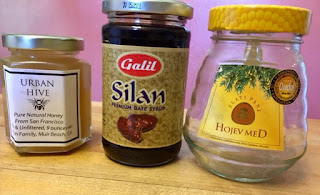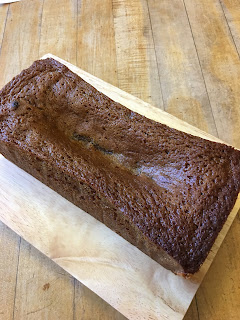Last fall, I didn't make honey cake for the Jewish holidays. It was a sad season that marked the beginning of a very hard year. First, the death of my mother Alice in February. Five months later, the death of my father-in-law Murray, who is remembered on this blog for his kreplach and gedempte chicken recipes. And in the last month, we have faced a few more family health challenges.
And so I return to this blog, after an absence of many months. And once again it is time to make honey cake for Rosh Hashanah--and to hope for a sweeter new year for all of us.
The last time I made honey cake, two years ago, an unusual recipe for honey cake had started making the rounds of Jewish publications. The year before, I had finally arrived at a recipe for what I called the Best-ever Jewish Honey Cake. It was an adaptation of a recipe from the great food writer Claudia Roden. Except for a slight cosmetic problem (sinkholes in the middle) I couldn't have asked for anything better. But now this new recipe, and the story behind it, had caught my eye.
The recipe was the creation of Lior Lev Sercarz, owner of a high-end spice store in New York City and author of two cookbooks. This Israeli-born chef and spice expert wanted to capture the flavors of his childhood, so he made a few changes to the traditional holiday sweet that is strongly rooted in the Eastern European (Ashkenazi) Jewish tradition.
 |
| California honey, Israeli date syrup (silan), Slovenian honey (med) |
I tried his recipe twice. Once with good Slovenian honey and once with a jar of date syrup I found in a local Middle Eastern grocery. The honey loaf was quite good, with a sharp anise flavor and a nice light texture, although my husband preferred the slightly richer and moister version from the previous year. The version with date syrup was less successful, perhaps because I used coffee instead of pomegranate juice and had to use a little rye flour when I ran out of white. The sprinkle of sesame seeds on top was a nice touch. And these loaves didn't sink at all, as you can see from the photo below.
L'Shana Tova!
Spicy Jewish Honey Cake ( Claudia Roden meets Lior Lev Sercarz)
2 large eggs
1 cup light brown sugar
1/2 cup oil (part or all olive oil)
1 cup honey (or silan/date syrup)
2 T. rum
1/2 cup pomegranate juice
2 cups white flour
1-1/2 t. nutmeg
1-1/2 t. ginger
1 T. whole anise seed
1-2 t. baking powder (use less to avoid sinkholes!)
1/2 t. baking soda
pinch of salt
optional: mix in 1/2 cup broken walnuts 1/3 cup cranberries/apricots or other fruit
optional: sprinkle with sesame seeds after baking
First, prepare pans. Line a 9-inch spring form pan with foil, then oil and dust with flour. Or use three small loaf pans, 3 x 7 inches, oiled and lined with parchment paper. Set aside. Preheat oven to 350 degrees.
In a medium-sized bowl, mix together the flour, spices, baking powder, and baking soda. Set aside.
In a small bowl, toss walnuts and dried fruit in a little flour to coat. Set aside.
In a large bowl, beat eggs with sugar until thick and lemon-colored. Add oil, honey, rum, and pomegrante juice. Beat until smooth. Add dry ingredients slowly to liquid ingredients, beating until smooth. Finally, fold in the optional nuts and dried fruits.
Pour batter into prepared pan(s). Bake at 350 degrees until top is firm and springs back when touched, about 45 minutes for small loaf pans for 1 hour and 15 minutes for a large spring form pan. Let cool on a rack. When cool, wrap in foil. If you can, wait at least a day or two before slicing and eating.





No comments:
Post a Comment